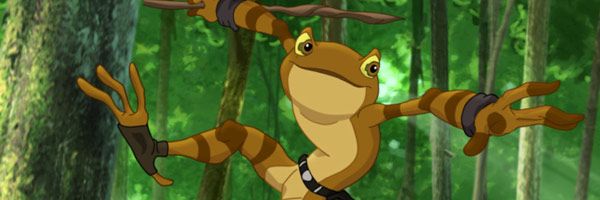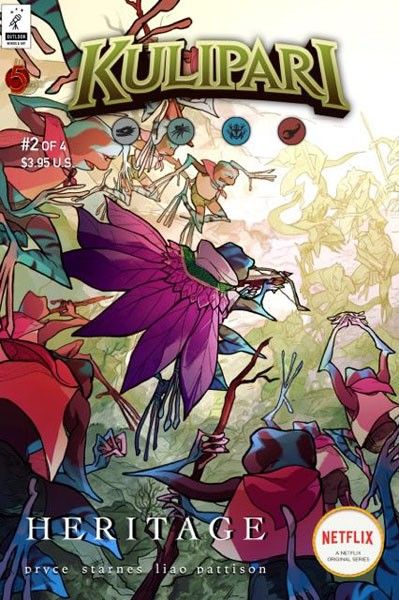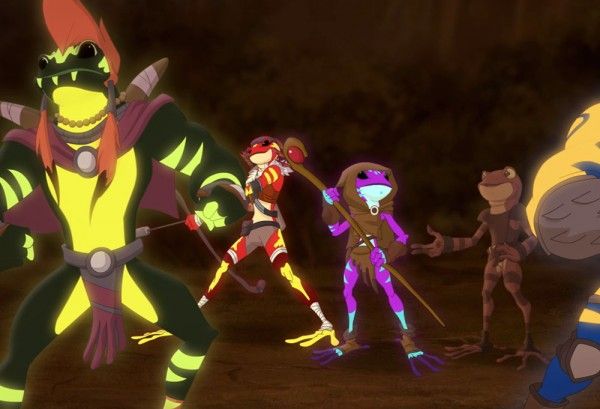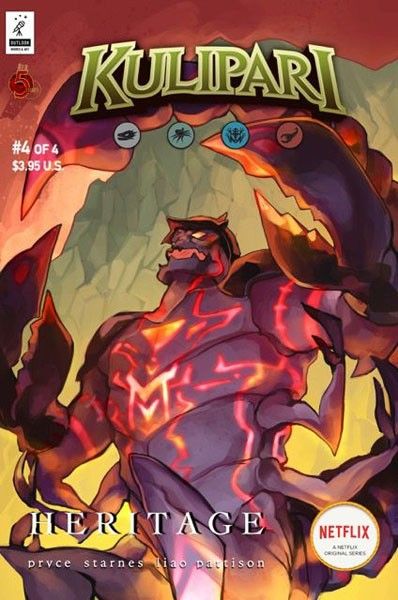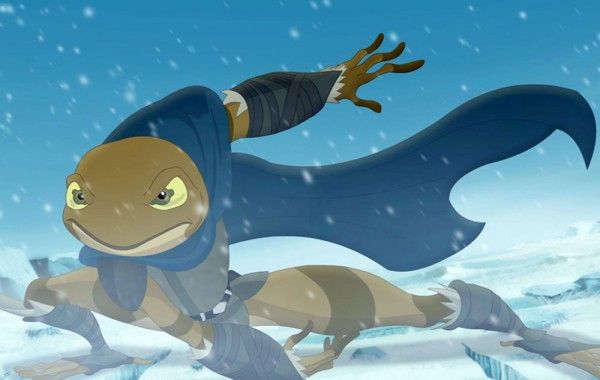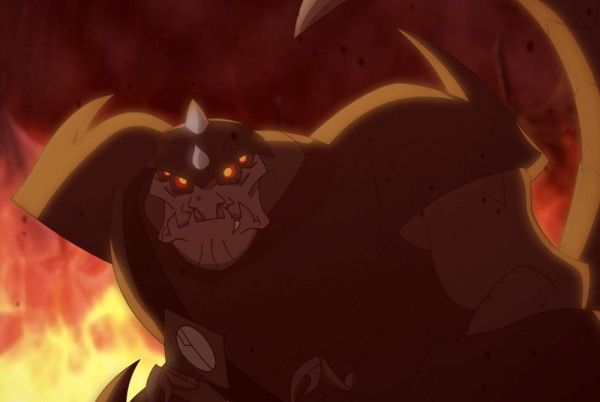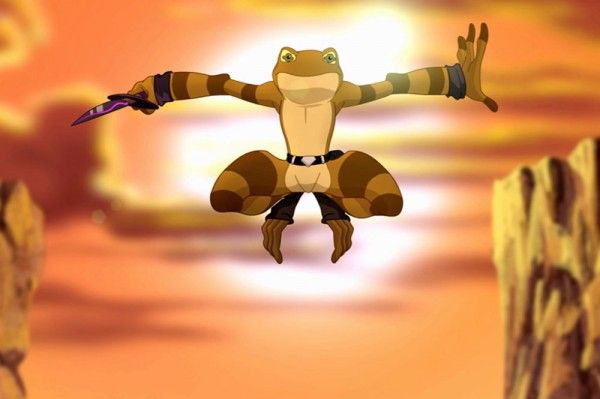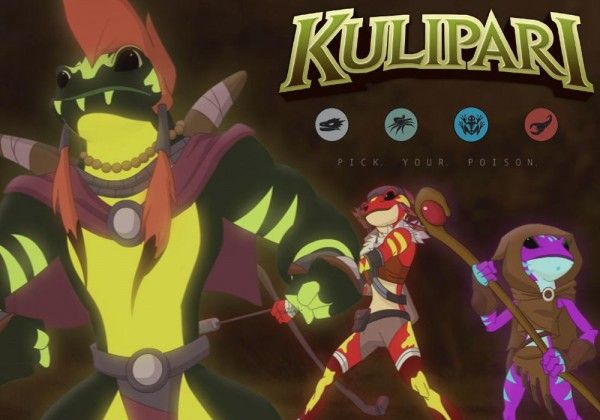Trevor Pryce, former NFL player and two-time Super Bowl champ with the Denver Broncos, has focused his attention on entertainment, to great success, since leaving professional sports behind. Kulipari: An Army of Frogs, his fantasy world for children about fearless frogs who go to war against sinister scorpions and spiders, which already includes a trilogy of books, has now also debuted as a 13-episode animated series on Netflix.
During this exclusive phone interview with Collider, Trevor Pryce talked about how Kulipari is a multi-faceted creative enterprise that’s just getting started, what inspired the idea, how long he’s been developing this world, the work ethic the NFL has given him, what it’s been like to work with Netflix, seeing and hearing his characters brought to life, and future possibilities. He also talked about another kids’ show he’s working on, called Bounce n Hounds: Lost n Hound, and other future endeavors.
Collider: You’ve written a trilogy of books, you’ve made a season of a TV series, and you’re doing a series of comic books. When did you start to think about and develop this world, and did you always know that it would work in so many different mediums?
TREVOR PRYCE: I started developing it around 2006. I was traded from Denver to Baltimore and, in my off-seasons, I got a chance to really dive into other things. I owned a record label, at the time, and the natural progression of any music executive is to want to make movies. So, I came up with a bunch of movies, but none of them went anywhere, except for this one. You have happy accidents, and this was a happy accident, no question. But when you have those happy accidents, you figure out very quickly what else you can do. The problem with Teenage Mutant Ninja Turtles is that, if you have something in that universe and it doesn’t star one of those four turtles, than it’s not Teenage Mutant Ninja Turtles. The reason, among a bunch of other reasons, why Star Wars is infinitely expandable is because it’s just called Star Wars. It’s not named after a character, or anything like that. So, the fact that I called this Kulipari without knowing that was just a happy accident. Disney’s success, with things like The Lion King and Mulan, was from the cultures that they found stories in. The only culture that they have not done is the Aboriginal culture, and that’s what Kulipari is based in. So, I looked at what Disney does because I wanted to make it relatable, interesting, something different, and something that people find colorful. Everyone has a story of good and evil, but it’s the color around it. The world Kulipari actually means poison in Aboriginal dialect, and frogs, scorpions, spiders and lizards makes it the most dangerous place in the world. The Great Barrier Reef is the second most dangerous place in the world. And we’re surrounded by the Marvel and DC way of universe building, so it actually becomes quite simple. Now, I can do anything I please and it all fits.
Initially, were you thinking, “If I can just make a movie, then I’ll be happy,” or did you want to explore as many different areas as you could with this world?
PRYCE: I’ve yet to be asked that question. What happened was that I wanted to make Kulipari a movie. I was not into the idea of IP ownership. I just wanted to transition from one career to the next. But, my agents were somehow able to finagle a book deal out of some character art that I had commissioned and my movie treatment. So, once the book deal was done, I sold it to Cartoon Network. I thought, “It won’t be a movie, but it’s going to be a book and a cartoon. That’s great!” But what you figure out very quickly is that, when you have a specific way you see it in your mind and they don’t see it that way, no matter how big or small that partner is, you have to take it form them. And they didn’t see it the way I did, so that was the end of that. At that point, I realized that it was time for me to take the bull by the horns and get my George Lucas on.
Anyone who works with Netflix talks about what a great environment it is to do a show because they don’t really give a lot of notes, and the ones that they do give are useful and helpful. Has that been your experience?
PRYCE: Yeah, I got nothing from them. They read the books and knew the vision, and they didn’t want to change it. One of the main executives at Netflix took time to read the books. That’s somebody who has a job that requires all of his attention. How he found time to read books of mine is beyond me, to be honest. Because they read the books, I knew it was the right place because they understood the nature of the story and the world I was trying to build. They were 100% on board, and that was important to me.
Would you suggest that people start with reading the books, and then watch the TV series and pick up the comics, or do you see the books and the TV series as supplemental of each other?
PRYCE: I honestly think the books are a better story, and the reason they’re a better story is because the original idea that I had was to do three seasons, one for each book. But what we found out very quickly was that those three seasons would have taken 10 years, and the books would have been 10 years old. So, very quickly, we decided to combine the first three books into one story, and then we’ll make something else, later on. I had to change a lot. I had to add some characters that weren’t in the book and had to change some motivations. The books are a slow burn. The series is a slow burn, but it’s a little faster. The tropes are the same and the characters are the same. It is Kulipari: Army of Frogs. But I would suggest that, if you have the time, read the books. I do think the books are a more robust story.
It sounds like you’d have a different experience with each medium.
PRYCE: Yeah. It’s the same story, but you do have a different experience. The series is an interpretation of the books. The animated series dives a little more into the humor of the characters and the world. The series is really a starting point, for myself and for Netflix. They love it and I can’t speak highly enough for their support of it, but it really is a starting point. The next season of this will be a story that I’ve written just for the series.
You’ve talked about this all coming from a childhood fear of frogs. Has creating this world and these characters rewritten that script for you? Do you have less of a fear of them now?
PRYCE: I have less of a fear because I’m a grown up. I’m 41 years old. But even as a kid, I was never scared of poisonous frogs. There was something different in the colors and in the vibrancy of what Mother Nature did to them. They’re like that to ward off predators, but I thought they were so cool. I always wanted one. It’s not a good idea for a pet, but I found nothing wrong with them. Bullfrogs are another story. I think I almost passed out once, when I was 10, when someone threw one at me. It was about me realizing that it’s just another animal. And then, when I started making the frogs, it brought back some of that. Now, I live in Maryland and there’s frogs all over my driveway, and my wife is petrified. We have these sliding glass doors that open up and make a wall in my house disappear. When we first moved in, we had a weird summer and frogs, and all kinds of other stuff, would go up into the tracks above the doors. I didn’t know there was a frog in there, so when I opened it, a frog fell down, but he was missing a leg. The tracking cut his leg off. I was like, “What in the what?!” Panic ensued in my house. I had to shovel his leg and his body into this thing, so that I could take him over to the woods and say a prayer for him. So, my fear of frogs has waned, substantially, because I’m a grown up and, if I don’t get the frog out, my wife sure as hell isn’t going to do it, and neither are my kids.
When you created and developed this world, were you thinking about what you’d what to see, personally, or were you thinking about the audience that it would appeal to?
PRYCE: All of that. I wanted to do what hasn’t been done yet. I remember watching Planet Earth, which was a huge influence on Kulipari. The original Planet Earth is one of the top three TV shows ever produced. I was just enthralled by it. I remember watching one on the Amazon jungle, and they had these frogs flying through the air like superheroes. That was the initial inspiration. I was like, “That hasn’t been done yet,” so that kicked off the idea.
How much did this story change and evolve before what we see now?
PRYCE: The original version of this was not for kids. It was called Poison, and it was going to be like 300. The original idea for this had something to do with radiation having killed everything, and now the scorpions were the size of school buses. It was really bonkers. I just went there. And then, I had some friends read it and they were like, “You can’t do that!” And I was like, “Why not?!” But, I found out that there was a cooler world in here. My son is 10 years old and, as he’s grown up, he’s grown up with Kulipari. He tells me what’s hip and what’s not hip. I said, “Hey, son, how about a scorpion the size of a school bus?” And he said, “No, dad, don’t do that.”
When you were a professional athlete in the NFL, did any of your teammates have any idea that this is what you were thinking about and what you wanted to do, beyond that, or are they all shocked about this path you’ve gone down?
PRYCE: No, they’re not shocked, at all. It wasn’t like I was walking around going, “Hey, I’m a writer. Look at my typewriter and my nebbish glasses.” They all had an idea about the creative part of me, like I had an idea of whatever they like. When you’re a professional athlete, forget what the sport is that you’re getting paid for, you spend more time with your teammates than your family. When you have that, you learn more about them than you want to learn, and they knew all of that about me. I didn’t walk around wearing it on my sleeve, but other people talked about it. So, they aren’t surprised, whatsoever, just like I wouldn’t be surprised by what any of them do.
To succeed in this business, you really need to have a relentless focus while everybody tells you, “No.” Did you find that you were able to apply the discipline in being a professional athlete to making this new venture happen?
PRYCE: Yes, that is my advantage. The hyper-focus on what I’m doing, and seeing that through from start to finish, really helped. Kulipari is not a new idea. It’s 10 years old. It’s just that people are just now hearing about it. But just like being a professional athlete, you have to be hyper-focused because these things take time. The other thing it’s done is that I have no fear of anybody. An executive at Sony is just a guy. Football coaches say, “Your opponents are nameless and faceless. It’s some guy in a uniform with a number on it.” So, I have no problem going to the president of a company, or cold-calling them and saying, “Here’s what I’m doing.” Being a professional athlete, I’ve learned how to talk to people differently. I have as much to offer you as you have to offer me, and I’m talking about big conglomerates. And when you’re a professional athlete, you cannot be late for anything. If you’re late, you are fined tens of thousands of dollars. So, that’s the way I do things. That’s just the way my world works. That’s where I come from. Anybody will tell you that I have no fear and that I need everybody to pull their weight.
You decided to take this TV series on and finance it yourself. Were you nervous about doing that?
PRYCE: No, I wasn’t, at all. It was more, “If I don’t do it, who’s going to?” I knew my idea was validated. I wouldn’t have had a book deal for my idea, if it wasn’t worth anything. My publisher published Diary of a Wimpy Kid. The Cartoon Network wouldn’t have bought the show, for the two days they had it. I wasn’t nervous, at all. People kept saying, “What if it fails?,” but I was like, “What if it doesn’t?” There were plenty of ideas that I’ve had where I’ve been like, “No, I’m not going to put money toward this,” and some of those were ideas that other people liked. You know when you have something and when you don’t, and I knew I had something. That’s not ego talking, it was research. There’s nothing like this. When I called Mattel out of the blue, I wound up with a toy deal. They kept saying, over and over again, “This just doesn’t happen.” But I spent a lot of time, energy and willpower getting it right, before I started taking it around. There was a lot of planning. It wasn’t a leap of faith.
Having lived with this world for so long, in your own head, what’s it like to see it brought to life in animated form and with voice actors playing these characters?
PRYCE: The animation, I had seen before. When the second book came out, the illustrator who did the books, Sanford Greene, started his own animation company, so I asked him to animate me a one-minute trailer for the second book. With that, I got to see the characters move, but there was no talking in it. What really threw me over the edge was when I heard my characters talk. There’s Mark Hamill, who plays two characters, Keith David, Josh Keaton and Wendie Malick, and they were all great. They sent me a bunch of voices and didn’t tell me who was who. They would send me 10 people for a character, and they weren’t reading sides. They just read random shit and I had to decide on one. So then, hearing them talk was really cool.
Do you have other projects that you’re currently developing?
PRYCE: Yes, and I’m staying in the same genre of action-adventure. Right as I was coming up with Kulipari, I was writing a comic book about the Gold Rush. It’s Pirates of the Caribbean meets the Gold Rush, and it’s about a character named Foster Broussard. That’s a graphic novel, and that comes out this year. That was another movie script that I had written, and the reason I made it a comic book was because of the comic book craze and every studio looking for a comic book IP. It didn’t matter how big the comic book was because it acted like a storyboard for them and they could see the movie. And then, I have four shows in development with BBC Worldwide that are non-fiction shows based on really cool people that I know, but none of them star me. And then, the last thing I have is a pre-school show that I sold to Disney Junior a long time ago and I just got back. That’s called Bounce n Hounds: Lost n Hound. Hounds is the name of his dog. It’s a Basset Hound that he calls Hounds. So, I’m keeping busy, busy, busy.
Kulipari: An Army of Frogs is now available at Netflix.

